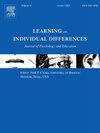Students' situational motivation in climate education – a multilevel profile approach
IF 9
1区 心理学
Q1 PSYCHOLOGY, EDUCATIONAL
引用次数: 0
Abstract
In the present study, we aimed to identify how students' motivation varied in various learning situations in climate education. The motivation was evaluated through interest, competence, perceived task difficulty, effort and anxiety based on situated expectancy-value theory. Using ecological momentary assessment, we collected data from 3695 situations of 354 Finnish upper secondary school students. By applying Multilevel Latent Profile Analyses, six situational motivation patterns were identified: Amotivating situations (15 %), Difficult situations (9 %), Moderately motivating situations (50 %), Low demanding situations (12 %), Easy situations (9 %), and Highly motivating situations (5 %). Situational patterns were differently associated with various learning activities. Based on the relative prevalence of situational patterns, three student motivation profiles were identified: Weakly motivated (21 %), Moderately motivated (59 %), and Interested and competent (20 %). Results showed that there are more science programme students and males in the Interested and competent profile. In addition, students in science programmes had higher test scores.
Educational relevance statement
Climate change is an important part of the Finnish school curriculum today. However, research has not yet found the single best way to motivate students to learn about it, including how to mitigate or adapt to it. This highlights the need to find new ways to motivate students on these important topics. Therefore, we investigated students' motivation in several learning situations to gain information on how students' motivation varies in different learning activities in the climate education module. Our findings showed that motivation to learn about climate change varies from situation to situation and from student to student. No learning style is suitable for everyone, but our research suggests that project-based learning could be a good way to teach about climate change. The issues should first be explored together, and then students can come up with solutions to the problems themselves. In addition, the results showed that a previous interest in science leads to higher motivation. Men were found to have higher levels of interest and competence.
气候教育中学生情境动机的多层次研究
本研究旨在探讨气候教育中不同学习情境下学生学习动机的变化。基于情境期望-价值理论,从兴趣、能力、感知任务难度、努力和焦虑四个方面对动机进行评价。采用生态瞬间评价法,我们收集了354名芬兰高中生3695份情境数据。通过应用多层次潜在特征分析,确定了六种情境动机模式:激励情境(15%)、困难情境(9%)、中等激励情境(50%)、低要求情境(12%)、简单情境(9%)和高度激励情境(5%)。情境模式与不同的学习活动有不同的关联。基于情境模式的相对流行程度,我们确定了三种学生动机类型:弱动机(21%)、中等动机(59%)和感兴趣和胜任(20%)。结果显示,有兴趣和能力的理科学生和男性更多。此外,理科专业的学生考试成绩更高。教育相关性声明气候变化是当今芬兰学校课程的重要组成部分。然而,研究还没有找到一个最好的方法来激励学生了解它,包括如何减轻或适应它。这凸显了寻找新方法来激发学生对这些重要话题的兴趣的必要性。因此,我们调查了学生在几种学习情境中的动机,以了解学生在气候教育模块中不同学习活动中的动机是如何变化的。我们的研究结果表明,学习气候变化的动机因情况和学生而异。没有一种学习方式适合所有人,但我们的研究表明,基于项目的学习可能是一种教授气候变化的好方法。首先应该一起探讨这些问题,然后学生自己想出解决问题的办法。此外,研究结果表明,先前对科学的兴趣会导致更高的动机。研究发现,男性的兴趣和能力水平更高。
本文章由计算机程序翻译,如有差异,请以英文原文为准。
求助全文
约1分钟内获得全文
求助全文
来源期刊

Learning and Individual Differences
PSYCHOLOGY, EDUCATIONAL-
CiteScore
6.60
自引率
2.80%
发文量
86
期刊介绍:
Learning and Individual Differences is a research journal devoted to publishing articles of individual differences as they relate to learning within an educational context. The Journal focuses on original empirical studies of high theoretical and methodological rigor that that make a substantial scientific contribution. Learning and Individual Differences publishes original research. Manuscripts should be no longer than 7500 words of primary text (not including tables, figures, references).
 求助内容:
求助内容: 应助结果提醒方式:
应助结果提醒方式:


